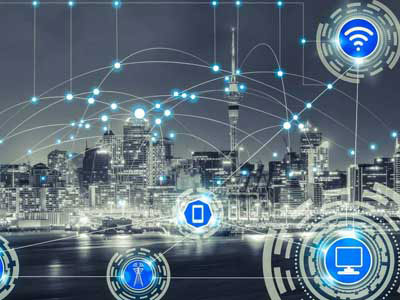Key Takeaway
The Internet of Things (IoT) in industry refers to a network of physical objects, or “things,” embedded with sensors, software, and technologies. These objects connect and exchange data with other devices and systems over the internet.
In industrial applications, IoT enhances automation, efficiency, and data collection. Sensors on machinery collect data, which is then analyzed to improve operations, predict maintenance needs, and reduce downtime. IoT is revolutionizing industries by making systems smarter and more responsive.
Defining IoT in the Industrial Context
IOT, or the Internet of Things, is a network of interconnected devices that communicate and share data with each other. In the industrial context, IoT involves using sensors, devices, and software to collect and exchange data. This data helps in automating processes, monitoring equipment, and enhancing efficiency. Think of IoT as a bridge connecting various machines and systems, allowing them to “talk” to each other. For instance, sensors on a production line can detect abnormalities and alert maintenance teams immediately, preventing downtime.

Evolution of IoT in Industry
The journey of IoT in the industry began with simple machine-to-machine (M2M) communication. Initially, M2M focused on basic data transfer between devices. Over time, advancements in technology transformed M2M into a sophisticated network of smart devices, revolutionizing industrial operations. At first, IoT applications were limited to basic monitoring and control. However, the advent of cloud computing, big data, and advanced analytics has significantly evolved IoT capabilities. Today, IoT enables predictive maintenance, real-time monitoring, and advanced automation. Industries have shifted from reactive to proactive management, enhancing productivity and reducing costs. This evolution reflects a broader trend towards digital transformation in manufacturing and industrial processes, driven by the need for efficiency and competitiveness. As IoT technology continues to advance, its applications in the industry will likely expand, offering even more innovative solutions for operational challenges.
Core Functions of IoT in Industrial Settings
IoT plays several crucial roles in industrial settings. Firstly, it enables real-time monitoring of equipment and processes, continuously collecting data to identify inefficiencies and optimize operations. This real-time data helps industries make informed decisions, improving overall productivity. Secondly, IoT facilitates predictive maintenance by analyzing data to predict machine failures, preventing unexpected breakdowns and extending equipment lifespan. Additionally, IoT enhances safety by monitoring hazardous conditions and triggering alerts, ensuring a safer work environment. Lastly, IoT improves supply chain management by providing real-time visibility into inventory levels and logistics, ensuring timely delivery of materials. This comprehensive approach to data management and operational efficiency makes IoT indispensable in modern industrial settings. By leveraging IoT, industries can achieve significant cost savings, improve safety standards, and enhance operational efficiency, making it a critical component of industrial automation and management strategies.
Benefits of IoT for Industrial Processes
Implementing the Internet of Things (IoT) in industrial processes offers substantial advantages. One major benefit is increased efficiency. IoT automates routine tasks, reducing manual intervention and accelerating workflows. For example, real-time data from IoT devices can streamline inventory management and optimize supply chains, enhancing overall productivity.
Another significant advantage is cost savings. With predictive maintenance enabled by IoT, companies can foresee equipment failures before they occur, minimizing downtime and reducing maintenance costs. Efficient resource management through IoT also ensures optimal use of materials, cutting down on waste and expenses.
IoT also plays a critical role in improving product quality. By enabling precise control and monitoring at every stage of the production process, IoT ensures consistency and high standards. Sensors and smart devices can detect anomalies and deviations, allowing for immediate adjustments to maintain product quality.
Furthermore, IoT enhances safety in industrial environments. Continuous monitoring of conditions, such as temperature, humidity, and machinery performance, helps prevent accidents and ensure a safer workplace. IoT devices can trigger alarms and automatic shut-offs in hazardous situations, protecting both workers and equipment.
Future Prospects of IoT in Industry
The future of IoT in industry is bright, driven by technological advancements and innovative applications. One key development is the integration of artificial intelligence (AI) with IoT, enabling smarter decision-making and further automation. For instance, AI can analyze IoT data to optimize production schedules, reduce energy consumption, and enhance operational efficiency.
The advent of 5G technology is another game-changer for IoT in industry. With its high speed and low latency, 5G will make IoT networks more reliable, allowing for real-time applications and seamless connectivity. This will be particularly beneficial in complex industrial environments where split-second decisions are crucial.
Industries are also likely to see increased adoption of IoT to gain a competitive edge. By leveraging IoT, companies can improve their operational efficiency, drive innovation, and stay ahead in the market. IoT will enable more precise control over manufacturing processes, leading to higher quality products and reduced waste.
Moreover, the future will witness the rise of more specialized IoT applications tailored to specific industry needs. For example, in the automotive industry, IoT can be used for advanced vehicle tracking and fleet management, while in agriculture, IoT can optimize irrigation and crop monitoring.
Overall, the future prospects of IoT in industry are promising, with the potential to revolutionize how businesses operate, improve efficiency, and foster innovation. Industries that embrace these advancements will be well-positioned for success in the evolving technological landscape.
Conclusion
IOT is revolutionizing industries by enabling smarter, more efficient operations. It connects devices and systems, facilitating real-time data exchange and automation. The evolution of IoT from simple M2M communication to advanced networks has transformed industrial processes, enhancing efficiency, safety, and productivity. As technology advances, the future prospects of IoT in industry are bright, promising further innovations and improvements. Embracing IoT is crucial for industries looking to stay competitive and achieve sustainable growth in the digital age.
